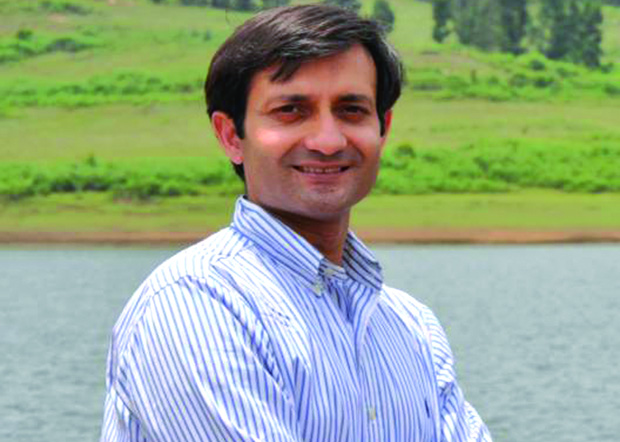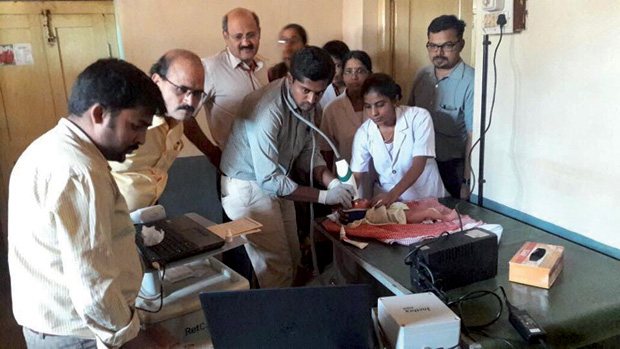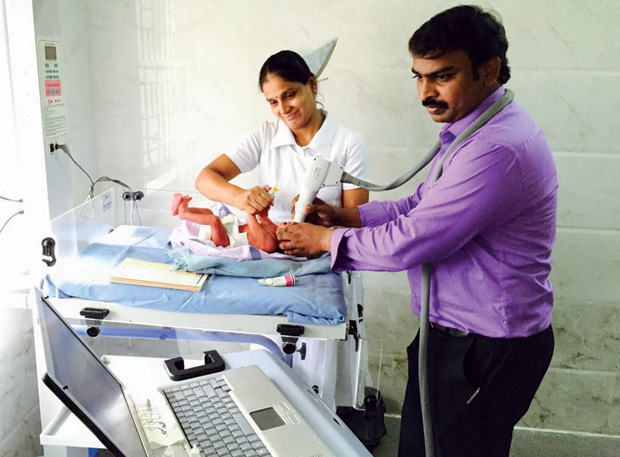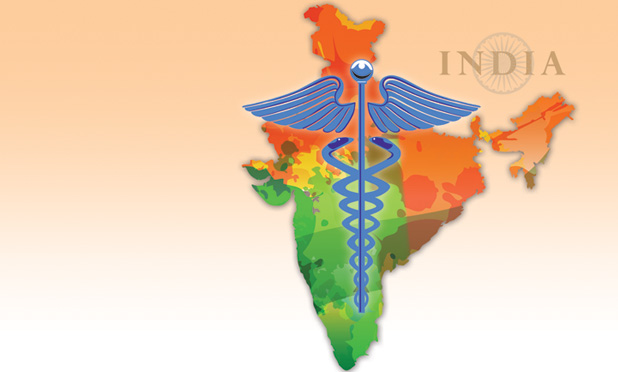How would you provide effective and affordable health care in a country of more than 1.25 billion where there are only 0.7 physicians for every 1,000 people [1]? The Revised National Tuberculosis Control Program (RNTCP) and the Karnataka Internet-Assisted Diagnosis of Retinopathy of Prematurity (KIDROP) service are two notable efforts designed to deliver care across India, in both urban and rural areas and from the country’s flat plains to its rugged mountainous and desert regions.
RNTCP uses mobile communication and short message service (SMS) technology to alert tuberculosis (TB) patients of the need to take medicine or visit the nearest care center for followup. If patients do not acknowledge these reminders, health care workers visit them to encourage that they continue treatment. This comprehensive protocol has resulted in a near 90% cure rate for TB. KIDROP, on the other hand, uses advanced image compression and communication technology to provide digital screening of retinopathy for infants living in remote areas who would otherwise not have access to the specialized facilities currently available only in select Tier-1 Indian cities. The service connects specialists in cities to patients who can access the facility via a mobile screening unit that can travel to remote locations carrying the retinal imaging and high-speed communication infrastructure.
A New and Better TB Treatment
TB is a highly infectious disease that generally remains latent, without many visible symptoms. Although only a tenth of affected patients die if left untreated, TB-related mortality is very high in developing countries, which account for almost 95% of the world’s affected population. The Tuberculosis Research Center, established in 1956 in Chennai, Tamil Nadu, proved that the age-old practice of treating TB in an isolated sanatorium with access to nutritious food and ample rest was, in fact, unimportant if adequate drug therapy is available and taken by patients. This supports research that TB patients treated at home do not risk contaminating family members; that revelation, in turn, revolutionized TB treatment globally. The National Tuberculosis Institute (NTI) was established in 1959 in Bengaluru, Karnataka, with the aim of training medical and paramedical professionals to deliver long-term comprehensive drug-therapy-based treatment across the length and breadth of urban and rural India.
To facilitate effective implementation, district TB centers (DTCs) were established. TB patients could travel shorter distances for diagnosis and periodic follow-up and also to pick up medication every week. They could speak with clinical counselors in their native language and discuss any reservations they might have related to their medications’ side effect. While these efforts were successful early on, the gradual withdrawal of NTI-trained medical and paramedical staff meant that the centers faced difficulties over time, with only 66% of enrolled patients taking medication regularly and an average default rate of 34%. This posed a challenge to the effective survival of the DTC model for TB treatment in India.
After years of review, the Indian government decided in 1992 to revamp the DTC program model with the aid of the World Health Organization (WHO) and the Swedish International Development Agency. It was determined that the program suffered from managerial weakness, inadequate funding, overreliance on X-rays for imaging- based diagnosis, nonstandard treatment regimens, low rates of treatment completion, and lack of systematic information on treatment outcomes. This led to the birth of the RNTCP [2], which was launched nationwide in 1997.
The RNTCP initially adopted the WHO-formulated directly observed treatment short-course (DOTS) strategy, which consists of five components:
- strong political will and administrative commitment
- diagnosis by quality-assured sputum smear microscopy
- uninterrupted supply of quality-assured short-course chemotherapy drugs
- directly observed treatment
- systematic monitoring and accountability.
This helped achieve the target detection rate of 70% and a cure rate of 85%, which led to an overall decrease of TB incidence in the country. With this success, the 12th revised national plan was enacted to achieve a new target detection rate of 90% and a cure rate of 90% for new cases and 85% for retreatment cases between 2012 and 2017.
Digital Monitoring of TB
To further this goal, Project Nikshay was launched in 2012, with the government of India declaring TB a “notifiable disease,” thereby mandating that all stakeholders in the health care system notify the Central TB Division of Ministry of Health and Family Welfare about all diagnosed and treated cases. Project Nikshay is a web-based portal for monitoring TB patients and enabling effective implementation of the RNTCP. Developed by the National Informatics Center, Project Nikshay covers various aspects of controlling TB using web-based technology and SMS services. These technologies have been employed effectively for communication with patients as well as for monitoring the RNTCP program on a day-to-day basis, while also enabling national surveillance of the disease.
The process begins with the central offices receiving a hard copy form from public or private health care providers indicating a diagnosed case and providing details about the patient’s biometrics, disease history, whether it is a new or retreatment case, and pathological diagnostic test results, along with the name of the diagnosing and treating physician and any paramedic information. Submissions of new cases can also be done via SMS or telephone call. Once registered with Project Nikshay, the TB patient, paramedics, and health care workers in the patient’s home district receive alerts for providing effective care and monitoring DOTS implementation.
Some key features of Project Nikshay include SMS- and voice-based tracking and reminders for TB patients about their medicine intake. Once a patient is alerted with a reminder to take his or her regular dose of medicine, the project monitors for an acknowledgment SMS. If an acknowledgment SMS is not received within a day, the patient receives a call from a clinical counselor at the district central office. This has helped encourage patients who might have otherwise withdrawn to continue treatment, despite side effects caused by medication and the inability to interpret symptoms or seek help to reduce these side effects, as well as mobility restrictions leading patients not to contact health centers for drugs when stock depletes [3]. As most patients are from low socioeconomic situations and are often illiterate, many find it psychologically comforting to discuss their concerns with a counselor who speaks their native language and to seek assistance regarding nutrition. About 75% of the patients in the RNTCP regularly make phone calls to the central offices through Project Nikshay to discuss and receive feedback during the course of treatment. This has also helped RNTCP health care workers keep in touch with patients who are traveling or periodically relocating to stay with family members at different locations, which is typical. Each health care worker communicates with 15–20 patients per day in this arrangement.
The role of mobile phones in promoting adherence to DOTS medication administered by the RNTCP is gaining importance in India, which is particularly suited for a mobile-phone-based intervention given their widespread connectivity, low cost, and growing popularity. To facilitate health education and communication and reach a larger audience, the SMS system is now being made available in regional languages. Enlightening family members along with patients via mobile phones has also proven to be a good strategy for effective disease management. It seems likely that by harnessing digital and mobile technology, India will meet its target of achieving a TB diagnosis rate of 90% and a comprehensive treatment-based cure rate of 90% by 2017.
Telemedicine to the Rescue Against Infant Blindness in Rural Areas
The KIDROP service, established in 2008 in Bengaluru, Karnataka, is a nonprofit infant blindness prevention, detection, and treatment program that emerged from a partnership between private and public organizations in India [4]. The primary aim of this program is to screen infants for a potentially blinding condition termed retinopathy of prematurity (ROP) that affects prematurely born babies. The program extends its reach to remote and rural areas that are underserved and where no facilities, resources, or training exists for ROP screening. It uses skilled technicians, telemedicine, and passionate ROP experts, all committed to a program that has evolved in an ecosystem of pioneering technology, specialized training, and multidisciplinary teamwork.

KIDROP was started in 2008 as an exploratory venture by Dr. Arvind Vinekar (Figure 1) with the Narayana Nethralaya Postgraduate Institute of Ophthalmology, Bengaluru, Karnataka, at five centers in rural and semi-urban Karnataka. Owing to its overwhelming success over its first year, since 2009 it has been functioning as a public–private partnership along with the National Rural Health Mission, Ministry of Health and Family Welfare. The objective of KIDROP is to create a network using telemedicine to prevent, screen for, and treat blindness in rural infants who lack access to care for ROP that is replicable and scalable to all levels of health care throughout the country. Since its inception, KIDROP has trained technicians to screen infants at peripheral centers using a special infant retina-imaging camera. These technicians store, read, analyze, grade, and upload the images from the rural center using an indigenously developed Internet-based picture archiving and communication system. The images are then delivered in real time to a remotely located expert ophthalmologist on his or her iPhone, personal computer, or iPad for diagnosis. The technician at the remote location receives live reports delivered through the Internet-based server to read and provide to others.
By the end of the third quarter of 2012, 18 districts in Karnataka had been included, and currently more than 81 hospitals are being screened by three teams in different geographical zones of the state (Figures 2 and 3). The model has also been replicated in parts of Maharashtra and Gujarat with the assistance of the KIDROP team. Observing its success, countries like Thailand, Indonesia, Russia, Mexico, the Dominican Republic, South Africa, and Brazil have also expressed interest in implementing the KIDROP model locally.
Today, these models represent some of the unique initiatives the government of India is spearheading such as Digital India, launched in 2015, which envisions connecting citizens to government services electronically by improving online infrastructure and Internet connectivity. Through such initiatives, we eagerly look forward to a better future.


References
- The World Bank. (2016). Physicians (per 1,000 people). [Online].
- Central TB Division, “National strategic plan for tuberculosis control, 2012–2017,” Ministry of Health and Family Welfare, Government of India, New Delhi, 2012.
- R. Elangovan and S. Arulchelvan, “A study on the role of mobile phone communication in tuberculosis DOTS treatment,” Indian J. Community Med., vol. 38, no. 4, pp. 229–233, Oct.– Dec. 2013.
- KIDROP. (2014, Apr. 25). KIDROP Karnataka Internet-Assisted Diagnosis of Retinopathy of Prematurity. [Online].



